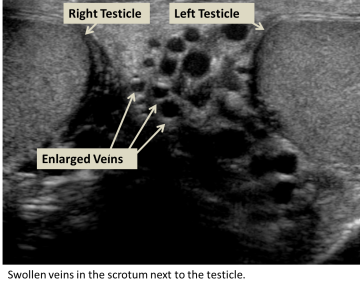Varicocele
Find your care
Our board-certified physicians diagnose and treat many vascular conditions. Call 310-481-7545 to learn more about interventional radiology services.
What is a varicocele?
A varicocele is an abnormal enlargement of veins in the scrotum. Normally, veins bring deoxygenated blood back to the heart, but when the blood cannot flow properly, blood builds up and causes veins to dilate. Disruption in blood flow can result from problems with or missing valves in the veins or blockage of the veins. Blockage of the veins can be caused by blood clots, tumors, enlarged lymph nodes, or compression between other blood vessels. Varicoceles are similar to varicose veins, which occur in the legs.

Risk Factors
Varicoceles are common and occur in about 15% of males, particularly those between ages 15 to 25. Beginning during puberty, varicoceles typically grow slowly over time. Although most varicoceles are idiopathic (not the result of another condition), if a varicocele appears suddenly in men over age 40, kidney tumors should be considered.
Symptoms
Most varicoceles are asymptomatic, but the following symptoms may be present in the scrotum:
- Visible enlarged veins
- Enlarged veins feel like a bag of worms
- Pain
- Heaviness
- Shrinking of the testes, worse on side with varicocele
- Worse symptoms as the day progresses
- Symptoms improve when you lay down
Not all varicoceles affect fertility, but they are a common cause of decreased fertility. Most varicoceles are on the left side, and one third of patients are affected on both sides. Right side only varicoceles likely indicate that a clot or tumor may be blocking blood flow.
Diagnosis
The physician will perform a physical exam, but if the varicocele is small, it can be difficult to see or feel. During the exam, you will be asked to stand and hold your breath while bearing down, also known as the Valsalva maneuver, as the physician feels the scrotum for enlarged veins. An ultrasound may also be ordered to see the veins and testes sizes.
Treatments
The interventionalist will make a small incision in the groin and enter the femoral vein. Next, using a series of wires and tube the testicular vein will be accessed. The gonadal vein will be occluded. Different approaches can be used to occlude the vein including placement of sclerosants, coils, as well as other techniques. See our varicocele embolization page for more information on treatment.
For More Information:
For more information or to schedule an appointment with one of our IR physicians, please call 310-481-7545.